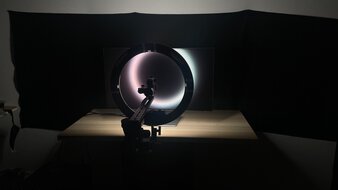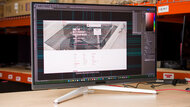
Although most monitors work with your MacBook Pro or MacBook Air, some are better than others, with a few advantages. Monitors with USB-C ports make it easy to display an image and charge your laptop with the same cable, as long as it supports enough power for your laptop. Most monitors support DisplayPort Alt Mode, and some have Thunderbolt support, which can make full use of your MacBook's ports. While macOS is optimized for use with monitors that have a pixel density of 110 or 220 PPI, not all monitors have this exact pixel density, so the next best alternative is to use your MacBook with any resolution you prefer, and make sure text looks sharp.
There are other factors you should consider depending on your usage. For example, having good color accuracy is important for content creation, and it's good to get something with deep blacks and bright highlights if you work with HDR content. We evaluate these different factors as part of our extensive testing, which includes nearly 400 tests, including monitors' macOS compatibility by testing with a 2023 MacBook Pro (M2 Pro) and a 2024 MacBook Pro (M4 Max). The results are also valid for any chip and MacBook, including the MacBook Air.
We've bought and tested more than 355 monitors, and below are our recommendations for the best external monitor for MacBook Pro, including the best MacBook Air monitors. Also, check out our recommendations for the best monitors for Mac mini, the best monitors for Mac Studio, and the best monitors for programming. If you're shopping for a laptop, check out the best Apple laptops and MacBooks.
Quick Look





Best Monitor For MacBook Pro
 Office8.4Editing8.0Color Accuracy8.6HDR Picture6.1SDR Picture7.5SDR Brightness8.4Size32"Pixel TypeIPSMax Refresh Rate120 HzNative Resolution3840 x 2160Pixel Density140 PPIUSB-C DisplayPort Alt ModeYesThunderboltThunderbolt 4See all our test resultsUSB-C Power Delivery140W
Office8.4Editing8.0Color Accuracy8.6HDR Picture6.1SDR Picture7.5SDR Brightness8.4Size32"Pixel TypeIPSMax Refresh Rate120 HzNative Resolution3840 x 2160Pixel Density140 PPIUSB-C DisplayPort Alt ModeYesThunderboltThunderbolt 4See all our test resultsUSB-C Power Delivery140WThe best monitor for MacBook Pro that we've tested is the Dell U3225QE. You can buy it directly from Dell. It's fantastic to use with your MacBook, mainly because it supports Thunderbolt 4. This means it can take full advantage of MacBooks that support up to Thunderbolt 4, and even though the models with M4 Pro and M4 Max chips support Thunderbolt 5, you'll still get fast data transfer with those. With 140W of power delivery, it can also charge your MacBook with one cable while you're using it. It has other useful features, like Thunderbolt and DisplayPort video outputs, so you can connect two extra monitors directly to this one, ideal if you want a multi-monitor setup.
Even if you're just going to use this monitor and connect different computers to it, it's a great choice because it has a large USB hub and a KVM switch, making it easy to use the same devices on both. It's also a good display for content creators, thanks to its accurate sRGB mode and sharp images with its 4k resolution. However, it has limited HDR picture quality due to its low contrast ratio. Its 32-inch screen offers plenty of screen space, but you can also consider the Dell U2725QE if you want something smaller and cheaper. However, it has worse accuracy before calibration.
Best Apple Monitor For MacBook Pro
 Office8.3Editing7.4Color Accuracy9.4HDR Picture2.4SDR Picture7.0SDR Brightness8.7Size27"Pixel TypeIPSMax Refresh Rate60 HzNative Resolution5120 x 2880Pixel Density218 PPIUSB-C DisplayPort Alt ModeYesThunderboltThunderbolt 3See all our test resultsUSB-C Power Delivery96W
Office8.3Editing7.4Color Accuracy9.4HDR Picture2.4SDR Picture7.0SDR Brightness8.7Size27"Pixel TypeIPSMax Refresh Rate60 HzNative Resolution5120 x 2880Pixel Density218 PPIUSB-C DisplayPort Alt ModeYesThunderboltThunderbolt 3See all our test resultsUSB-C Power Delivery96WWhile the Dell U3225QE is a fantastic monitor to use with your MacBook Pro or MacBook Air, if you want an Apple-specific monitor to complete your ecosystem, then check out the Apple Studio Display. There are a few advantages to getting it, like the fact that it has a higher 5k resolution for even sharper text. Plus, it has a few features that you can only access with a macOS device, like its extremely accurate sRGB mode, and you can change its settings directly from your MacBook Pro or MacBook Air. It also has a built-in webcam and microphone, which are neat perks that most monitors don't have.
However, there are still a few drawbacks to getting it over the Dell, namely the price increase. Its stand also has much worse ergonomics, but you can get a variant with a VESA-mount adapter if you prefer using an ergonomic stand or mount. Besides that, it doesn't support HDR at all, which is disappointing if you need something for editing videos in HDR. Apple offers the Pro Display XDR, which is a 32-inch, 6k monitor that supports HDR, but it also costs a lot more.
Best Ultrawide Monitor For MacBook Pro
 Office8.1Editing8.0Color Accuracy8.9HDR Picture6.2SDR Picture7.5SDR Brightness7.5Size40"Pixel TypeIPSMax Refresh Rate120 HzNative Resolution5120 x 2160Pixel Density140 PPIUSB-C DisplayPort Alt ModeYesThunderboltThunderbolt 4See all our test resultsUSB-C Power Delivery140W
Office8.1Editing8.0Color Accuracy8.9HDR Picture6.2SDR Picture7.5SDR Brightness7.5Size40"Pixel TypeIPSMax Refresh Rate120 HzNative Resolution5120 x 2160Pixel Density140 PPIUSB-C DisplayPort Alt ModeYesThunderboltThunderbolt 4See all our test resultsUSB-C Power Delivery140WIf you don't need an Apple-specific monitor and want the most screen space possible to work with your MacBook Pro or MacBook Air, then the Dell U4025QW is a fantastic option. While it's considered a 5k display like the Apple Studio Display as it has an ultrawide 5120x2160 resolution, it has lower pixel density, so text isn't as sharp, but it's still fantastic. That said, the main advantage is its 40-inch screen with a 21:9 aspect ratio, so there's plenty of space to open multiple windows at once, ideal if you work with a long video timeline, for example.
Like the Dell U3225QE, it also has a massive USB hub that includes five USB-A ports and five USB-C ports, so you can easily connect various devices, which is great if you don't have ports available on your laptop. It supports Thunderbolt 4 for fast data transfer, and you can even use this to daisy chain a second monitor if you want even more screen space, but it only has one video output, and not two like on the U3225QE. That said, if the U4025QW is beyond your price range, consider the less-expensive Dell U3425WE. It's similar to the U4025QW but has a smaller screen and lacks HDR support.
Best Mid-Range Monitor For MacBook Pro
 Office8.5Editing7.7Color Accuracy8.9HDR Picture5.5SDR Picture6.9SDR Brightness8.1Size27"Pixel TypeIPSMax Refresh Rate60 HzNative Resolution3840 x 2160Pixel Density163 PPIUSB-C DisplayPort Alt ModeYesThunderboltNoSee all our test resultsUSB-C Power Delivery90W
Office8.5Editing7.7Color Accuracy8.9HDR Picture5.5SDR Picture6.9SDR Brightness8.1Size27"Pixel TypeIPSMax Refresh Rate60 HzNative Resolution3840 x 2160Pixel Density163 PPIUSB-C DisplayPort Alt ModeYesThunderboltNoSee all our test resultsUSB-C Power Delivery90WIf you find that the monitors mentioned above are too expensive for your needs, there are some great work-friendly 4k monitors you can get for cheaper. One of those is the ASUS ProArt Display PA279CRV, which is a 4k, 27-inch monitor that's fairly similar in picture quality to the Dell U3225QE. However, the main downside of getting this is that it doesn't have Thunderbolt support. While this means that it won't take full advantage of your MacBook with the fastest possible data transfer, it still has DisplayPort Alt Mode, so you can display an image and charge the MacBook thanks to its 90W of power delivery. It doesn't have a KVM switch like the U3225QE either, but there are some USB ports to which you can connect your devices.
One of this monitor's strengths is its color accuracy. It's very accurate in its sRGB mode, and you'll only need to calibrate it if your work requires perfectly accurate colors. It also has picture modes for other color spaces you may work with, including DCI-P3 and Adobe RGB. Plus, it gets bright enough to fight glare in a well-lit room, but it performs worse in a dark room as it has a low contrast ratio.
Best Budget Monitor For MacBook Pro
 Office7.6Editing7.9Color Accuracy8.8HDR Picture8.0SDR Picture8.2SDR Brightness7.8Size27"Pixel TypeVAMax Refresh Rate180 HzNative Resolution2560 x 1440Pixel Density109 PPIUSB-C DisplayPort Alt ModeNo USB-C PortsThunderboltNoSee all our test resultsUSB-C Power DeliveryNo USB-C Ports
Office7.6Editing7.9Color Accuracy8.8HDR Picture8.0SDR Picture8.2SDR Brightness7.8Size27"Pixel TypeVAMax Refresh Rate180 HzNative Resolution2560 x 1440Pixel Density109 PPIUSB-C DisplayPort Alt ModeNo USB-C PortsThunderboltNoSee all our test resultsUSB-C Power DeliveryNo USB-C PortsIf you're looking for something on a budget, check out the AOC Q27G3XMN. It's different from the ASUS ProArt Display PA279CRV as it has a lower 1440p resolution, so images aren't as sharp and detailed, and it doesn't have a USB hub. This means you need to connect your laptop over HDMI or get a DisplayPort adapter. However, the AOC has even better HDR picture quality than the ASUS, as it uses Mini LED backlighting, which is something many low-cost monitors don't have. Its local dimming works well, so it displays deep blacks next to bright highlights, which is great if you want to use it in a dark room.
It's even a good choice if you're a content creator, thanks to its good picture quality. It has an accurate sRGB mode, but there are some issues with a red tint, depending on which combination of settings you use. This means you may have to calibrate it to avoid this issue. Besides that, it also gets very bright, which is ideal if you want to use it in a bright room.
Best Cheap Monitor For MacBook Pro
 Office7.1Editing6.3Color Accuracy7.8HDR Picture2.5SDR Picture6.7SDR Brightness6.6Size24"Pixel TypeIPSMax Refresh Rate100 HzNative Resolution1920 x 1080Pixel Density93 PPIUSB-C DisplayPort Alt ModeNoThunderboltNoSee all our test resultsUSB-C Power Delivery15W
Office7.1Editing6.3Color Accuracy7.8HDR Picture2.5SDR Picture6.7SDR Brightness6.6Size24"Pixel TypeIPSMax Refresh Rate100 HzNative Resolution1920 x 1080Pixel Density93 PPIUSB-C DisplayPort Alt ModeNoThunderboltNoSee all our test resultsUSB-C Power Delivery15WIf you're on a really tight budget to get a monitor after buying your new MacBook, a good alternative to the AOC Q27G3XMN is the Dell P2425H, which you can get for cheap directly on Dell's website. It's a noticeable step-down in picture quality from the AOC as it has a low contrast ratio and doesn't support HDR at all, but this is what you should expect for such a cheap display. It also has a smaller screen with a lower 1080p resolution, so images aren't as detailed and there's less screen space to work with. That said, text still looks fairly sharp on it.
While it's a simple office monitor that offers the basics, like wide viewing angles and a very ergonomic stand, it also includes a USB hub. This helps if you want to connect your devices directly to it. Although it also has a USB-C port, it doesn't support DisplayPort Alt Mode, and it's meant for data transfer or charging. Like with the AOC, you need to connect your MacBook to it via HDMI or with a USB-C to DisplayPort adapter.
Notable Mentions
- LG 40WP95C-W:
The LG 40WP95C-W is a 40-inch ultrawide monitor that competes with the Dell U4025QW. While it tends to cost less than the Dell, it has fewer features, as it has a smaller USB hub and lacks a KVM switch.
See our review - Dell S2722QC:
The Dell S2722QC is a budget-friendly 4k monitor that has a USB-C port. This makes it a good alternative to the AOC Q27G3XMN if you want something with a USB hub, but it also costs more and has worse picture quality.
See our review - ASUS ProArt Display PA27JCV:
The ASUS ProArt PA27JCV is a 5k monitor that's a cheaper alternative to the Apple Studio Display. While it's great overall and has a few extra features, like an ergonomic stand, it doesn't support Thunderbolt, and text isn't as clear.
See our review - Acer Nitro XV275K P3biipruzx:
The Acer Nitro XV275K P3biipruzx is a 4k monitor with better HDR picture quality than Dell U3225QE. It's something to consider if you edit content in HDR, but it doesn't have the same premium features as the Dell.
See our review - Dell P2423D:
The Dell P2423D is an entry-level work monitor that's an alternative to the AOC Q27G3XMN if you don't need the HDR support. It has a few extra perks, like a USB hub, but the AOC is still the better choice for most people.
See our review
Recent Updates
Jun 02, 2025:
We replaced the Acer Nitro XV275K P3biipruzx with the Dell U3225QE, which has Thunderbolt support, and for consistency with other recommendations. We also added the Dell P2425H as the 'Best Cheap.' Lastly, we added the XV275K, the ASUS ProArt Display PA27JCV, and the Dell P2423D to the Notable Mentions.
Apr 08, 2025:
We added the Apple Studio Display back in as the 'Best Apple Monitor' to better match expectations for the market. We also replaced the Dell U2723QE with the cheaper ASUS ProArt Display PA279CRV for consistency with other recommendations. We removed the LG 27GP850-B/27GP83B-B because it's hard to find. In the Notable Mentions, we replaced the Dell U3223QE with the newer Dell U3225QE and added the Dell S2722QC.
Feb 19, 2025:
We introduced a new format to the article and updated the text to reflect these changes. We replaced the Apple Studio Display with the Acer Nitro XV275K P3biipruzx, as it costs less, has HDR, and has better dark room performance. We replaced the Dell G2724D with the LG 27GP850-B/27GP83B-B, as the Dell is hard to find now. We added the Apple Studio Display as a Notable Mention.
Nov 13, 2024:
Verified our picks for accuracy and consistency and added the Dell P2425H as a Notable Mention.
Aug 21, 2024: We renamed the Acer Nitro XV275K P3biipruzx to 'Best Upper Mid-Range Monitor,' and replaced the Dell S2722QC with the Dell U2723QE, and renamed it to 'Best Mid-Range Monitor' to be more representative of the current monitor market. Lastly, we removed the Dell S2721QS from the Notable Mentions based on changes.
All Reviews
Our recommendations are based on what we think are the best external monitors for MacBook Pro and the best MacBook Air monitors. They are adapted to be valid for most people in each price range. The rating is based on our review, factoring in price and feedback from our visitors.
If you would prefer to make your own decision, here is the list of all of our monitor reviews. Be careful not to get too caught up in the details. Most monitors are good enough to please most people, and the things we fault monitors on are often not noticeable unless you really look for them.
Comments
Best Monitors For MacBook Pro: Main Discussion
What do you think of our picks? Let us know below.
Looking for a personalized buying recommendation from the RTINGS.com experts? Insiders have direct access to buying advice on our insider forum.
Update: Updated the text for relevance and clarity and made sure the products are in stock.
What do you think of these changes? Let us know
- 21010
I’m suprised that Philips X2HR didn’t appeared on the list. For 140$ seems like a best budget as upgrade step from superlux.
Update: We’ve validated our picks to ensure their availability. We’ve also checked our text for accuracy; there hasn’t been a change in our recommendations.
What do you think of these changes? Let us know














































































